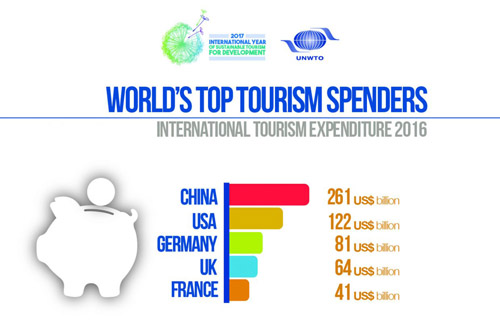According to a report issued by the United Nations World Tourism Organization (UNWTO), Chinese tourism spending grew by 12 percent in 2016, cementing China’s position as the world’s leading tourism market.
China increased its lead as the world's most valuable tourism market in 2016.
According to a report issued by the United Nations World Tourism Organization (UNWTO), Chinese tourism spending grew by 12 percent in 2016, cementing China’s position as the world’s leading tourism market. In total, 135 million Chinese travelers ventured abroad in 2016, representing a 6 percent increase on 2015’s figures—and marking the fifth consecutive year of China as the world’s number one source of international tourists.
Even though the growth in the total number of tourists has slowed down in recent years, the findings underline the growing affluence of China’s many international travelers, with the growth of average spending per traveler outpacing the overall growth of international travelers. In 2016, Chinese consumers spent US$261 billion on international travel, more than double the US$122 billion spent by consumers in the world’s second largest tourism market; the United States.
While China ranked sixth in the growth of travel spending among the 50 source markets surveyed, the 6 percent growth in international travelers puts it behind both many of its developing country peers, as well as the United States and many European countries. In comparison, international travelers from the United States grew by 8 percent in the same period, and the international travelers from the United Kingdom jumped by 7 percent despite the lower purchasing power of the pound sterling in 2016.
As a counterpoint to the figures published by UNWTO, the Chinese government reported that 122 million Chinese travelers ventured abroad in 2016, a 4.3 percent increase on 2015’s figures. However, the reliability of official Chinese tourism statistics is often put into question, as the Chinese National Tourism Administration (CNTA) has been found to retroactively change previous years’ numbers to show a higher level of tourism growth. For example, China originally reported 120 million outbound journeys for 2015, a number that was revised down to 117 million in October 2016, three months before announcing 4.3 percent tourism growth in 2016—which otherwise would have stood at 1.67 percent growth.
The substantial growth in tourism spending relative to the growth of overall international travel in China also underlines the ongoing shift in tourism consumption among Chinese consumers. China’s growing number of—often more affluent—free independent travelers (FITs) continues to be an important market trend, with Chinese travel consumption gradually shifting from low-cost group tours to higher-revenue independent travel and semi-independent travel. With the trend of Chinese independent travel showing few signs of slowing down, it can also be expected that growth in tourism spending will remain strong in the years to come. The recent crackdown on tourism to neighboring South Korea, one of the most popular tourist destinations for Chinese group tours, could, however, cause a drop in overall international travel in 2017.
“The latest data on outbound tourism spending are very encouraging. Despite the many challenges of recent years, results of spending on travel abroad are consistent with the 4% growth to 1.2 billion international tourist arrivals reported earlier this year for 2016. People continue to have a strong appetite for travel and this benefits many countries all around the world, translating into economic growth, job creation and opportunities for development,” Taleb Rifai, Secretary-General of the UNWTO, said in a press statement addressing the UN agency’s findings.
